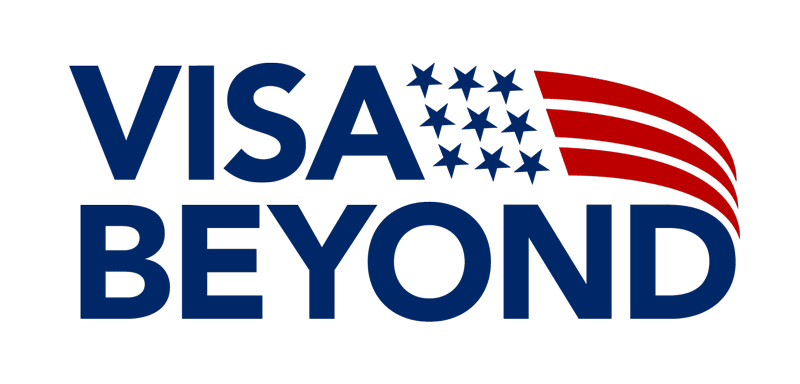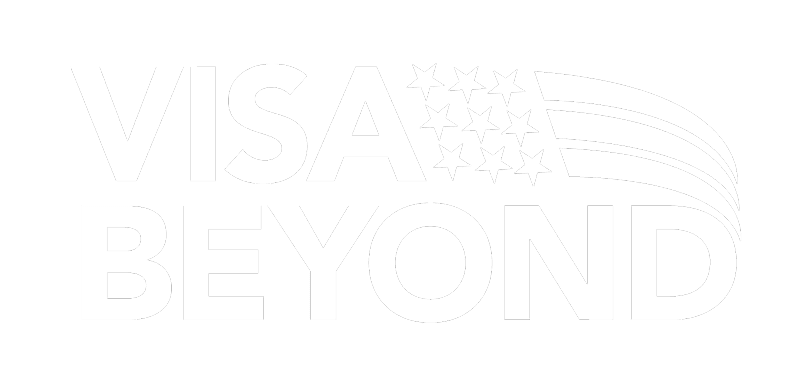L-1 Visa:
The Ultimate Guide
to Successful Navigation.
With the L-1 Visa, global companies can transfer top talent to the U.S., providing opportunities for work and long-term residency.
L-1 Visa holders can easily transfer between U.S. offices of the same company without needing a new visa, offering businesses and employees great flexibility. It’s a smart option for companies with multiple U.S. locations.
No Degree Requirement
Accessible to skilled professionals
without specific educational needs.
Easy Intra-Company Transfers
Seamlessly transfer key
employees across international offices.
Family Benefits
Spouses can work,
and children can live in the U.S.
Extended Stay for Executives
L-1A holders can
stay for up to 7 years.
Dual Intent
Allows pursuit of a Green Card
while maintaining visa status.
Client
Satisfaction
Years
in the business
What Is the L-1 Visa?
Key Benefits and Overview
The L-1 Visa is a non-immigrant visa that enables multinational companies to transfer managerial, executive, or specialized knowledge employees from their foreign offices to their U.S. operations. This visa category is crucial for businesses looking to expand their global footprint or streamline international operations. The L-1 Visa not only facilitates the movement of key personnel but also offers significant advantages such as no annual caps and the potential pathway to permanent residency.
What is the L-1 Visa Purpose?
The L-1 Visa is designed to strengthen U.S. businesses by allowing the transfer of essential personnel from foreign affiliates. It serves two primary purposes:
- Facilitating Global Business Operations: Enables multinational companies to move executives, managers, or specialized employees to the U.S. to improve management effectiveness, increase competitiveness, and expand U.S. exports.
- Establishing New U.S. Offices: Allows foreign companies without a U.S. presence to send key personnel to set up operations.
Key Benefits of the L-1 Visa
- No Quota Limitations: Unlike H-1B Visas, L-1 Visas are not subject to annual numerical caps.
- Duration Flexibility: L-1A Visas are valid for up to 7 years, while L-1B Visas are valid for up to 5 years.
- Pathway to Permanent Residency: L-1A Visa holders may qualify for the EB-1C Green Card category, often without the need for labor certification.
L-1 Visa Success Rate.
The success rate for L-1 Visa applications varies by year and specific visa type (L-1A for executives/managers vs. L-1B for specialized knowledge workers).
00%
Depending on
the visa type
L1 Visa Application Costs and Processing Timeline
An overview of fees and processing times for applying to the L1 Visa program.
Application Fees
- Form I-129 Filing Fee: $460
- Fraud Prevention and Detection Fee: $500
- ACWIA Fee: $750 - $1,500
- Premium Processing Fee: $2,500
Application Timeline
- Standard Processing Time: 2 to 6 months, depending on the service center.
- Expedited Processing: 15 days with premium processing
FAQs
About L-1 Visa.
Who qualifies for the L-1 Visa?
Employees in managerial or executive roles (L-1A) or those with specialized knowledge (L-1B) qualify.
What is the difference between L-1A and L-1B visas?
L-1A is for managers and executives, while L-1B is for employees with specialized knowledge.
How long can I stay in the U.S. on an L-1 Visa?
L-1A allows up to 7 years, and L-1B allows up to 5 years.
Can my family come with me on an L-1 Visa?
Yes, spouses and children under 21 can apply for L-2 visas and may work in the U.S.
Can I apply for a Green Card while on an L-1 Visa?
Yes, L-1A holders have a direct path to a Green Card without labor certification.
Is there a minimum salary requirement for the L-1 Visa?
No, there is no specific salary requirement for L-1 visas.
Can I work for another company on an L-1 Visa?
No, you can only work for the employer who sponsored your L-1 visa.
Can L-1 Visa holders switch to another visa type?
Yes, L-1 holders can change status to other visas like H-1B or apply for permanent residency.
Clients we
work for.
















L-1A vs. L-1B: Key Differences and Eligibility
The L-1 Visa category is split into two subcategories: L-1A for executives and managers, and L-1B for employees with specialized knowledge. Understanding the distinctions between them is essential for both employers and employees.
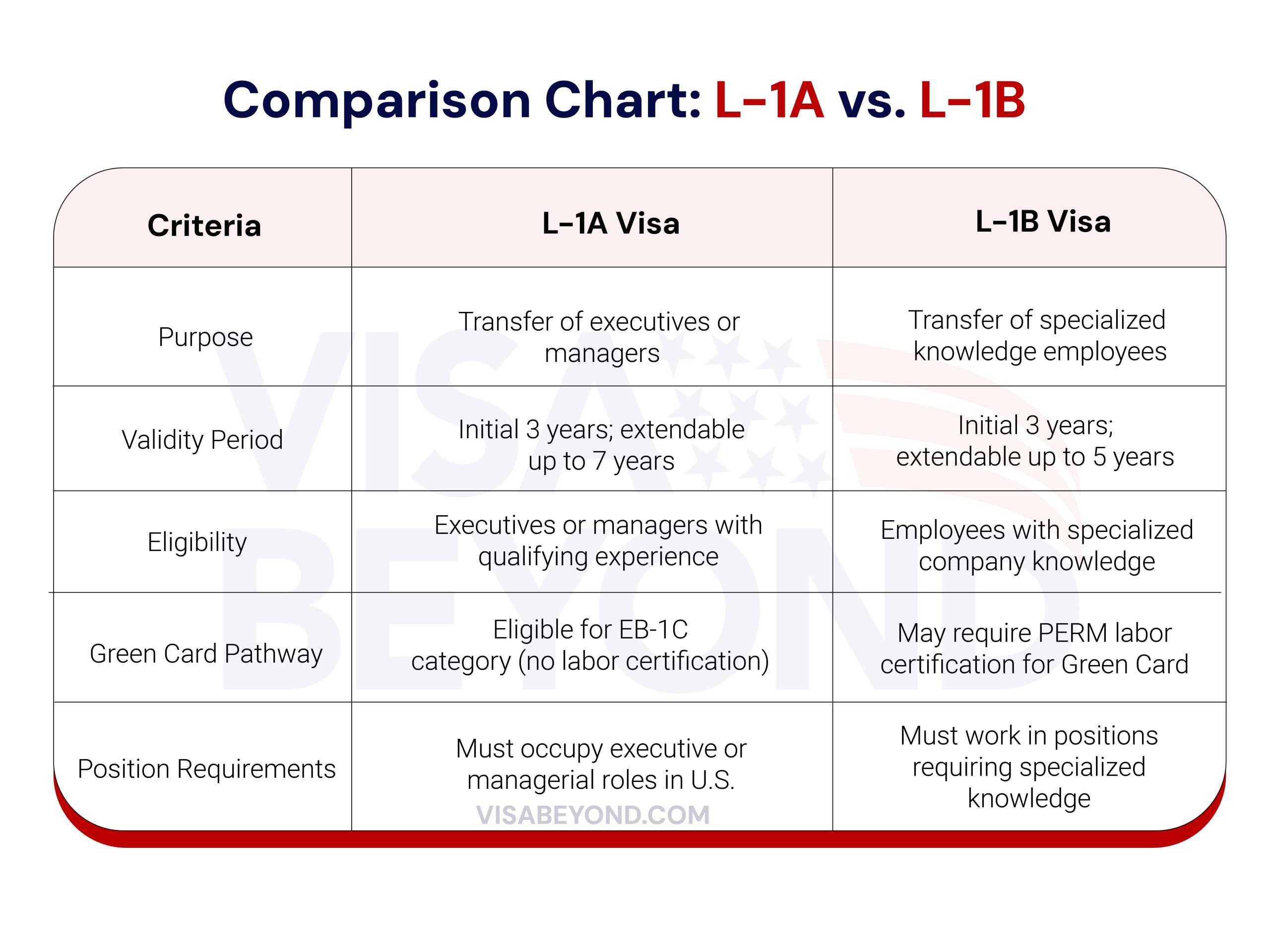
Who Qualifies for the L-1A Visa ?
To be eligible for the L-1A Visa, applicants must meet the following criteria:
- Employment Duration: Worked abroad for a qualifying organization for at least one continuous year within the last three years.
- Position Abroad: Held an executive or managerial role in the foreign company.
- U.S. Position: Will assume an executive or managerial position in the U.S. company.
- Qualifying Relationship: The foreign and U.S. companies must have a qualifying relationship (parent, branch, affiliate, or subsidiary).
Definitions:
- Executive Capacity: The employee has significant decision-making authority and directs the management of the organization or a major component or function. Refer to 8 CFR § 214.2(l)(1)(ii)(C) for detailed definitions.
- Managerial Capacity: The employee manages the organization, department, subdivision, or function, and supervises and controls the work of other supervisory, professional, or managerial employees.
Who is Eligible for the L-1B Visa ?
Eligibility criteria for the L-1B Visa include:
- Employment Duration: Must have worked for the qualifying foreign organization for at least one continuous year within the preceding three years.
- Specialized Knowledge: Possesses specialized knowledge about the company’s products, services, research, equipment, techniques, or management.
- U.S. Position: Will be employed in a role that requires such specialized knowledge.
- Qualifying Relationship: The foreign and U.S. entities must be parent companies, branches, subsidiaries, or affiliates.
Specialized Knowledge Includes:
- Proprietary Information: Knowledge that is unique to the employer and not commonly held in the industry.
- Advanced Expertise: Skills that are difficult to acquire in the labor market and are critical to the employer’s competitiveness.
Advantages of the L-1 Visa for Multinational Corporations
The L-1 Visa offers several strategic benefits to multinational corporations:
- Streamlined Employee Transfers: Simplifies the process of moving key personnel across borders, enhancing global operational efficiency. More details can be found on the USCIS L-1 Intracompany Transferee page.
- No Degree Requirement: Expands the pool of eligible employees, as there is no specific educational prerequisite.
- Establishing U.S. Presence: Facilitates the setup of new U.S. offices, allowing foreign companies to tap into the American market. Guidelines are available on the USCIS New Office L-1 Petitions page.
- Dual Intent Doctrine: L-1 Visa holders can pursue permanent residency without affecting their L-1 status, making it easier to retain valuable employees long-term.
- Family Benefits: Spouses (on L-2 visas) can obtain work authorization, and children can attend school in the U.S., enhancing employee satisfaction. For more information, visit the USCIS Family of L-1 Visa Holders page.
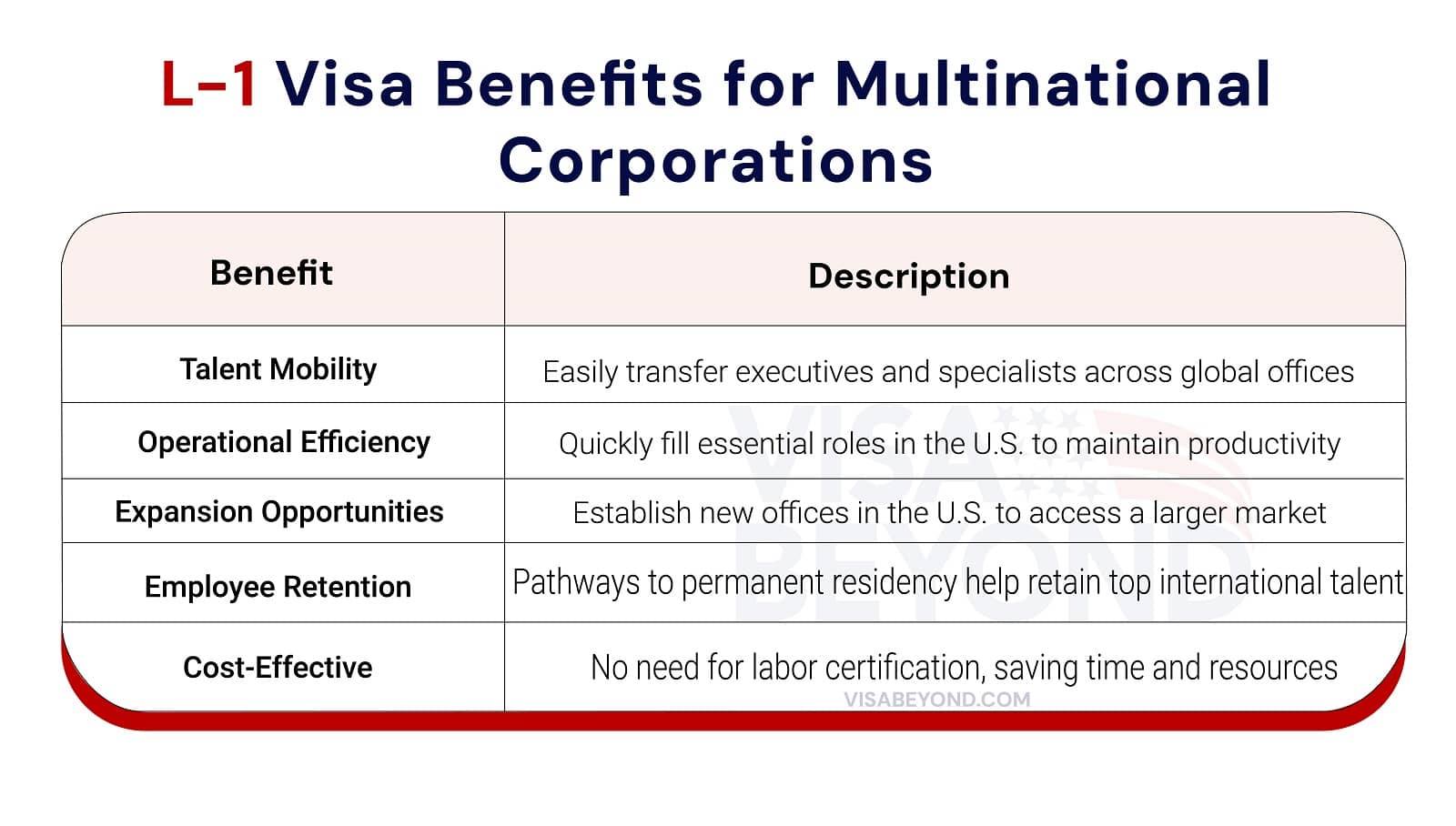
L-1 Visa Requirements: Essential Criteria for Employers and Employees
The L-1 Visa is a powerful tool for multinational companies to transfer key employees to the U.S., but both employers and employees must meet specific criteria. Employers must establish a qualifying relationship between their U.S. and foreign offices, while employees need to fulfill certain role and experience requirements. This visa is particularly beneficial for established companies, though startups can also qualify with the right strategies and planning.
L-1 Visa Employer Requirements : What Companies Need to Know
Employers seeking to transfer employees via the L-1 Visa must meet several essential requirements. The company must have a qualifying relationship with the foreign entity, and both the foreign and U.S. entities must remain operational throughout the visa duration.
Key Employer Requirements:
- Qualifying Relationship: The U.S. and foreign entities must be parent, subsidiary, affiliate, or branch offices.
- Ongoing Business: Both the U.S. and foreign entities must be actively conducting business during the employee’s transfer.
- Valid Operations: The U.S. office must be operating or, in the case of new offices, demonstrate the capacity to become fully operational within the visa period.
Qualifying Relationships and Organizational Structures
A key component of L-1 Visa eligibility for employers is demonstrating a qualifying relationship between the U.S. and foreign entities. This relationship must fit into one of the following categories:
- Parent Company: The U.S. or foreign entity owns the majority of shares or voting rights in the other.
- Subsidiary: One entity is fully or majority-owned by the other entity.
- Affiliate: The U.S. and foreign companies are owned by the same parent company or individuals with shared control.
- Branch: The U.S. office operates as a direct branch of the foreign company, without separate legal status.
These relationships must be clearly documented to qualify for the L-1 Visa. Legal and corporate documents such as shareholder agreements, organizational charts, and incorporation certificates may be required as evidence.
Employee Requirements for L-1 Visa Eligibility
For employees, the L-1 Visa requires a specific level of experience and a defined role within the organization. Employees must have worked for the foreign company for at least one continuous year within the last three years in an executive, managerial, or specialized knowledge role.
Required Experience and Role Definitions
L-1 Visa applicants must meet strict role definitions to qualify for the visa. Here’s a breakdown of what each role entails:
- Executive: An employee with significant authority to make decisions without much oversight. Responsibilities typically include directing the management of the company or a major function.
- Manager: An employee responsible for managing an organization, department, or subdivision. They must have direct supervisory duties over professional employees or manage a key function within the organization.
- Specialized Knowledge: Employees with advanced or proprietary knowledge about the company’s products, services, research, or techniques. This knowledge must be unique or significantly difficult to acquire in the open market.
This experience must be clearly outlined in the employee’s role description to ensure alignment with L-1 Visa criteria.
L-1 Visa for Startups : Challenges and Solutions
For startups, securing an L-1 Visa can be more challenging due to stricter requirements on business operations, profitability, and growth potential. New companies may struggle to demonstrate the necessary infrastructure or qualify for intra-company transfers, especially if they are just establishing a U.S. presence.
Common Challenges:
- Insufficient Operational History: Startups may lack a proven track record, making it difficult to demonstrate ongoing business.
- Limited Resources: Startups may not have the financial resources to show sustainability or rapid growth potential.
- New Office Setup: It can be challenging for startups to prove that their U.S. office will become operational within a year.
Strategies for Startups to Meet L-1 Visa Requirements
Despite the challenges, there are ways for startups to meet the L-1 Visa requirements:
- Create a Detailed Business Plan: A well-prepared business plan that outlines your growth strategy, revenue projections, and hiring plan can help demonstrate that the U.S. office will become operational and profitable.
- Leverage Existing Relationships: If your startup has a parent or affiliate company abroad, highlight this relationship clearly in your documentation to prove a qualifying connection.
- Show Financial Viability: Include evidence of capital investment, projected revenue streams, and initial contracts to show that the business can operate successfully.
- Focus on Key Hires: Ensure the employees being transferred to the U.S. have executive, managerial, or specialized knowledge roles that are critical to the startup’s success.
- Document U.S. Office Setup: Provide proof of your U.S. office location, lease agreements, and steps taken to establish business operations, such as opening bank accounts and forming partnerships.
By taking these proactive steps, startups can enhance their L-1 Visa applications and increase their chances of success.
How to Apply for the L-1 Visa:
Applying for the L-1 Visa involves a structured process that requires both the employer and employee to prepare and submit specific forms and documents. The process includes petitioning with the U.S. Citizenship and Immigration Services (USCIS) and possibly attending a visa interview. Following the steps carefully will help ensure a smooth application process.
L-1 Visa Application Process: Employer Responsibilities
Employers play a key role in the L-1 Visa application process. They must:
- File the L-1 Petition (Form I-129): Submit the petition to USCIS on behalf of the employee.
- Prepare Documentation: Provide documentation proving the qualifying relationship between the U.S. and foreign entities.
- Pay Filing Fees: Cover the required L-1 Visa application fees.
- Coordinate with Employee: Ensure that the employee’s documentation is accurate and complete for the petition.
Form I-129: Detailed Filing Instructions
Form I-129 (Petition for a Nonimmigrant Worker) is the main document employers need to file for L-1 Visa applicants. Here’s how to complete it:
- Download Form: Get the latest version of Form I-129 from the USCIS website.
- Complete Petitioner Information: Include company details, tax identification number, and authorized representative’s signature.
- Provide Employee Information: Include the employee’s details, such as full name, date of birth, and passport number.
- Attach Supporting Documents: Include documentation of the qualifying relationship between the U.S. and foreign entities.
- File with USCIS: Submit the completed form and supporting documents to the appropriate USCIS office.
For more detailed instructions, consult the Form I-129 instructions on the USCIS website.
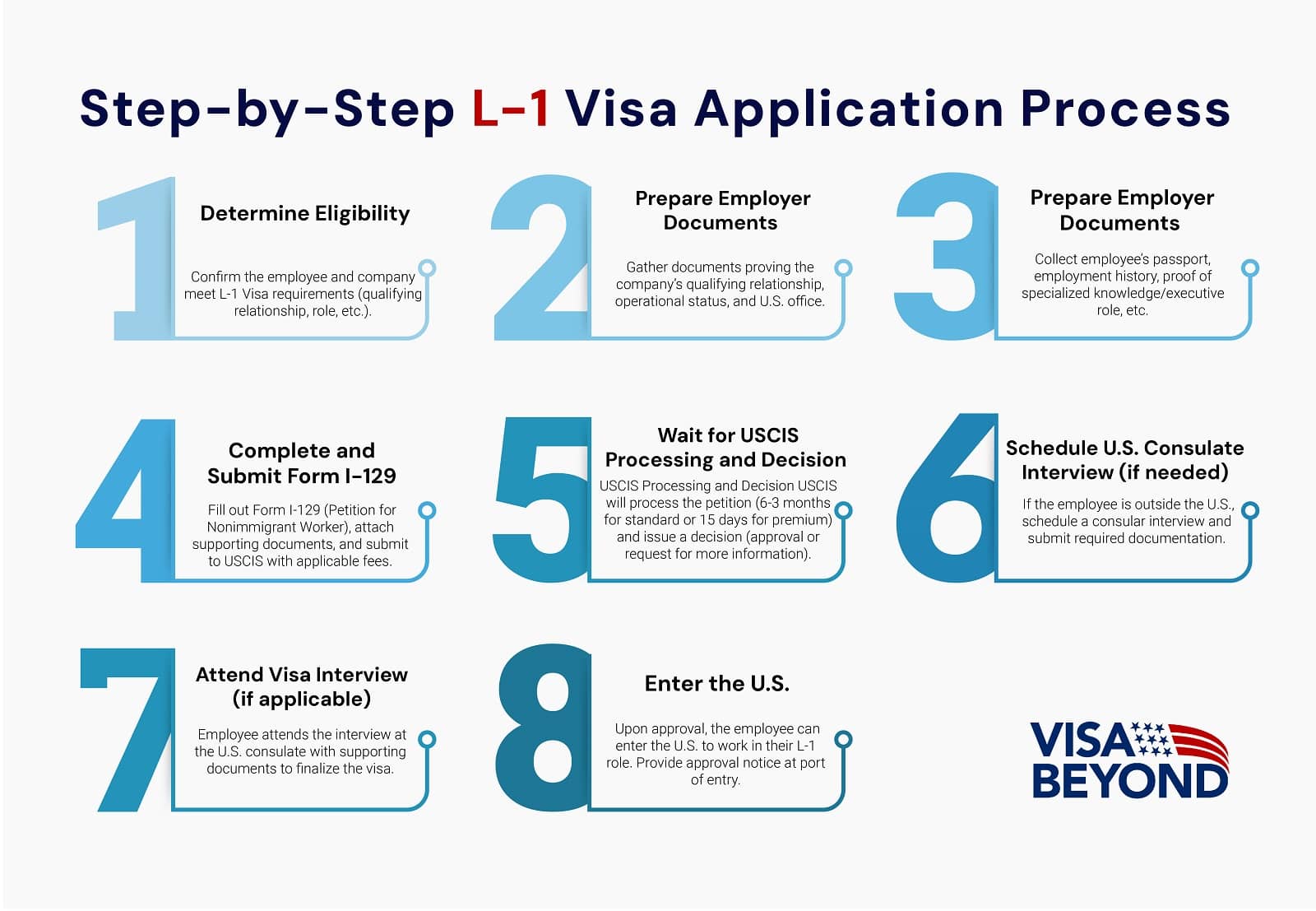
L-1 Visa Fees
The L-1 Visa fees vary depending on the type of petition and processing method:
- Basic Filing Fee: $460 for Form I-129.
- Fraud Prevention and Detection Fee: $500 for initial L-1 petitions.
- Premium Processing (Optional): $2,500 for expedited service.
L-1 Visa Documentation: A Comprehensive Checklist
Both the employer and the employee must submit specific documentation as part of the L-1 Visa application process. Having a complete checklist ensures that no vital documents are overlooked.
Employee Documentation Requirements
Employees need to submit the following documents as part of their L-1 Visa application:
- Passport: A valid passport with at least six months of validity.
- Resume: A detailed work history to support claims of executive, managerial, or specialized knowledge.
- Proof of Previous Employment: Pay stubs, employment contracts, or other documentation proving at least one year of employment with the foreign company.
- Job Description: A description of the U.S. role that aligns with the L-1 Visa requirements (executive, managerial, or specialized knowledge).
- Evidence of Active Business Operations: Tax returns, contracts, or financial statements showing that both entities are operational.
- Employment Offer Letter: A letter detailing the employee’s position, salary, and job responsibilities in the U.S.
How Long Does It Take to Get an L-1 Visa?
The time it takes to obtain an L-1 Visa depends on several factors, such as the complexity of the case, the service center handling the petition, and whether premium processing is used.
- Standard Processing: Typically takes between 3-6 months, depending on the workload at USCIS.
- Premium Processing: Expedites the decision within 15 calendar days, though this comes at an additional cost.
Visa issuance times at the U.S. embassy or consulate also vary, with most cases being processed within a few weeks after petition approval.
Standard vs.Premium Processing for L-1 Visas
L-1 Visa applicants have the option of choosing standard or premium processing:
- Standard Processing: Typically takes 3-6 months and is included in the base petition filing fee of $460.
- Premium Processing: Costs $2,500 and guarantees a response from USCIS within 15 calendar days.
For urgent business needs or time-sensitive transfers, premium processing can be a worthwhile option. If USCIS does not process the petition within the 15-day window, the premium processing fee is refunded.
L-1 Visa Validity, Extensions, and Renewals
The L-1 Visa offers flexibility for multinational companies, but understanding its validity, extensions, and renewal process is crucial to maintaining compliance. Employers and employees must ensure that the visa remains valid throughout the employment period and adhere to USCIS regulations when extending or renewing the visa.
Understanding L-1 Visa Validity Periods
The length of time an L-1 Visa is valid depends on the employee’s role and the type of visa issued. It’s important to know the initial validity period and the maximum stay allowed to plan for extensions or renewals.
Initial L-1 Visa Duration
- L-1A Visa (for executives/managers): Initially granted for up to 3 years.
- L-1B Visa (for specialized knowledge workers): Initially granted for up to 3 years.
- New Office Setup: If establishing a new U.S. office, the L-1 Visa is initially granted for 1 year.
Maximum Stay for L-1A and L-1B Visa Holders
- L-1A Visa: Maximum stay of 7 years.
- L-1B Visa: Maximum stay of 5 years.
After reaching the maximum stay, employees must leave the U.S. or switch to another visa category if eligible.
L-1 Visa Extensions: How to Stay Compliant
To extend an L-1 Visa, employers must file for an extension before the visa’s expiration. Staying compliant involves ensuring that the employee continues to fulfill their role in the U.S. and that the business relationship between the U.S. and foreign entity remains active.
Eligibility and Documentation for L-1 Visa Renewal
When renewing an L-1 Visa, the following documentation is typically required:
- Updated Business Operations Proof: Evidence that both the U.S. and foreign offices remain operational.
- Employee Role Verification: Proof that the employee is continuing in an executive, managerial, or specialized knowledge role.
- Tax and Financial Documents: Showing the business’s profitability and stability.
Renewals must be filed before the current visa expires to avoid lapses in employment authorization.
Maintaining L-1 Visa Status During the Green Card Process
L-1 Visa holders can apply for permanent residency (Green Card) without jeopardizing their L-1 status. However, it’s important to maintain compliance with the L-1 Visa’s terms during this process, ensuring no gap in employment or change in duties without proper filing.
Transitioning from L-1 Visa to Permanent Residency
L-1A Visa holders often transition to permanent residency through the EB-1C Green Card category, which does not require labor certification. L-1B Visa holders can apply for a Green Card through the EB-2 or EB-3 categories, often requiring labor certification.
The transition process typically involves:
- Filing the Form I-140 petition.
- Applying for Adjustment of Status (Form I-485) while maintaining valid L-1 status.
L-1 Visa Employee Transfers: Changing Locations or Roles
L-1 Visa holders may need to transfer between different company locations or take on new roles. To stay compliant, employers must ensure that any changes align with L-1 Visa requirements and report these changes to USCIS when necessary.
How to Transfer L-1 Visa Employees Within a Company
When transferring an L-1 Visa holder to another office within the same company, the employer must:
- File an amended Form I-129 to notify USCIS of the new work location.
- Provide documentation proving that the new location qualifies under the company’s L-1 operations.
Required Documentation for L-1 Visa Transfers
For internal transfers, employers must provide:
- Proof of Corporate Relationship: Showing that the new office is part of the qualifying organization.
- New Job Offer Letter: Outlining the employee’s responsibilities at the new location.
- Updated Organizational Charts: Demonstrating how the employee’s role fits into the new office structure.
Impact of L-1 Visa Transfers on Employee and Dependent Status
Transferring an L-1 employee to a new location may have implications for their visa status and their dependents (L-2 Visa holders). It’s crucial to ensure all visa statuses remain valid throughout the process.
Effect of L-1 Visa Transfers on L-2 Dependents
When an L-1 employee transfers to a new office, their L-2 dependents (spouse and children) may also need to update their visa status. If the L-1 employee is required to file an amended Form I-129, L-2 holders may need to file an extension or update their own records with USCIS.
Changing Job Roles on an L-1 Visa
L-1 Visa holders must remain in a qualifying executive, managerial, or specialized knowledge role. If an employee’s job duties change significantly, the employer must file an amended petition with USCIS. Failure to notify USCIS of changes in job roles could result in non-compliance, potentially affecting the employee’s visa status.
It’s essential to maintain clear communication between the employer, employee, and immigration counsel to ensure any changes are reported promptly and appropriately.
Overcoming L-1 Visa Challenges: Denials, RFEs, and Appeals
L-1 Visa denials and Requests for Evidence (RFEs) can be frustrating, but understanding the common reasons behind them and knowing how to respond effectively can significantly improve your chances of success. With careful planning, strong documentation, and attention to detail, many L-1 Visa challenges can be overcome.
Why Was My L-1 Visa Denied?
L-1 Visa denials are often due to issues with documentation or failing to meet key eligibility requirements. Common reasons for denial include:
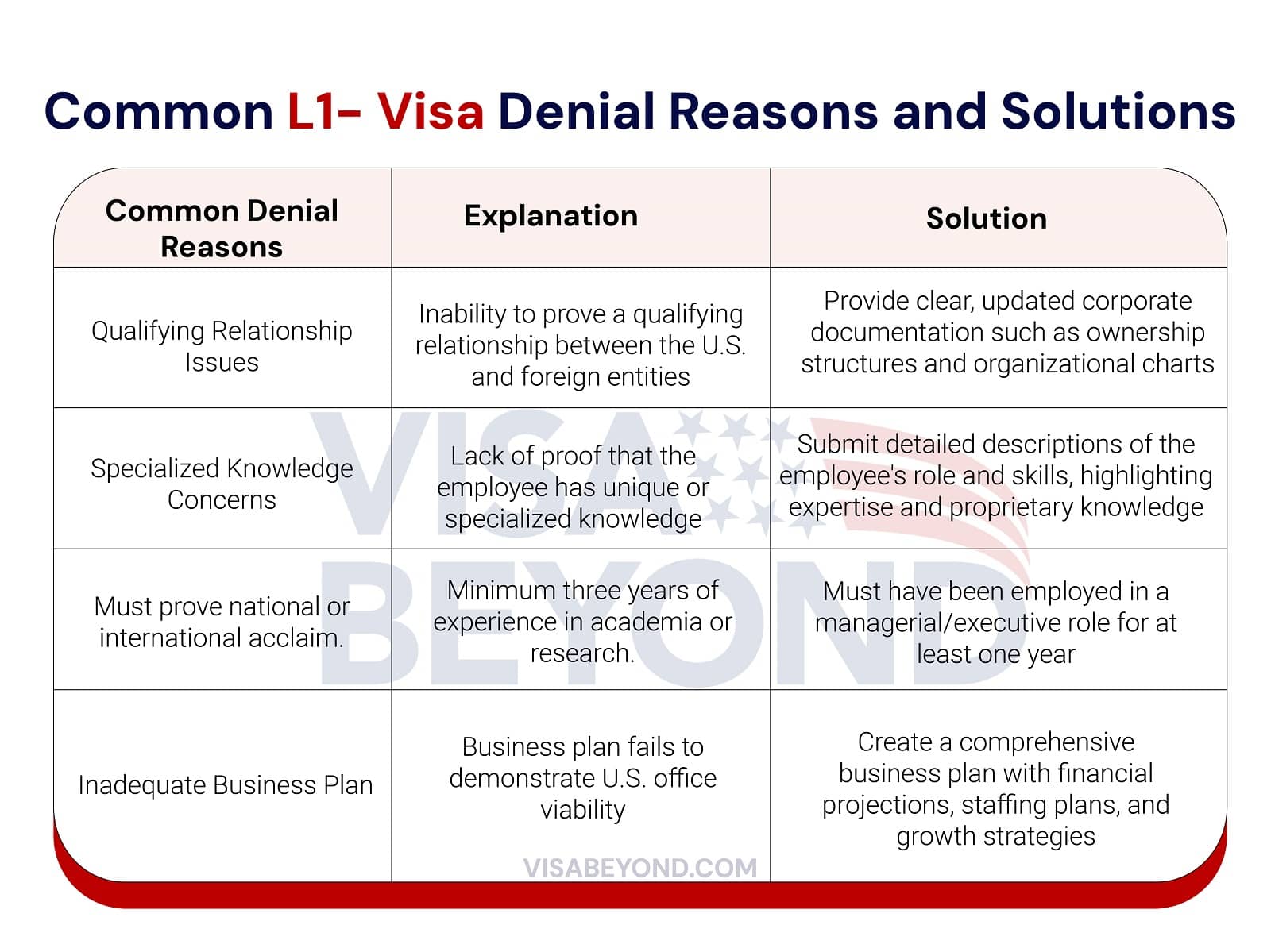
Qualifying Relationship Issues
One of the most common reasons for L-1 Visa denial is the inability to prove a qualifying relationship between the foreign and U.S. entities (e.g., parent, subsidiary, or affiliate). To address this, you should:
- Provide ownership documentation (shareholder agreements, financial statements).
- Submit organizational charts showing the hierarchy and control of both companies.
- Ensure the entities are engaged in active business operations, as dormant or shell companies may result in denial.
Challenges with Specialized Knowledge for L-1B
For L-1B applicants, denials may occur if the USCIS questions whether the employee truly possesses specialized knowledge. Common challenges include:
- Lack of clear job descriptions: Ensure that the employee’s role is clearly defined with specific examples of the specialized skills required.
- Insufficient evidence of proprietary knowledge: Include documentation that highlights proprietary processes, technology, or techniques that the employee uses.
Solution: Provide examples of how the employee’s knowledge is unique compared to the industry standard, and demonstrate the value of this knowledge to the U.S. business.
Responding to a Request for Evidence (RFE) on L-1 Visa
An RFE is a request by USCIS for additional information or documentation. It is not a denial, but failing to respond properly can lead to one. RFEs are often issued for missing or unclear documentation related to the employee’s role, the qualifying relationship, or specialized knowledge.
How to Successfully Address an L-1 RFE
To successfully address an RFE, follow these steps:
- Review the RFE Thoroughly: Understand the specific information USCIS is requesting.
- Provide Clear and Concise Documentation: Submit all requested documents, ensuring they address the specific concerns outlined in the RFE.
- Work with Legal Counsel: Immigration attorneys can help you craft a thorough and accurate response to the RFE.
Example: If the RFE requests proof of specialized knowledge, provide detailed job descriptions, training records, and letters from supervisors attesting to the employee’s expertise.
How to Appeal an L-1 Visa Denial: Your Legal Options
If your L-1 Visa is denied, you have several legal options:
- File an Appeal: Submit an appeal to the Administrative Appeals Office (AAO) to have the decision reviewed.
- File a Motion to Reopen or Reconsider: Request USCIS to reevaluate your case based on new evidence or errors in the initial decision.
Each option requires a strong understanding of immigration law and solid supporting documentation.
Filing a Motion to Reopen or Reconsider
- Motion to Reopen: Submit new evidence that wasn’t available during the initial petition, such as updated corporate documents or more detailed employee qualifications.
- Motion to Reconsider: Argue that USCIS misinterpreted the facts or law in its initial decision.
Both motions require detailed documentation and must be filed within 30 days of receiving the denial notice.
Understanding the Administrative Appeals Office (AAO) Process
The AAO handles L-1 Visa appeals. After filing an appeal, the AAO reviews the original decision and any new evidence provided. The process can take several months, and the AAO will either uphold or overturn the denial.
What to Do After an L-1 Visa Denial: Exploring Alternatives
If your L-1 Visa is denied and the appeal process is not viable, consider other U.S. visa options, such as the H-1B Visa or O-1 Visa. These visas may offer an alternative pathway to work in the U.S., depending on the employee’s qualifications and job role.
Let’s Make Your U.S. Dreams a Reality.
L-1 Visa to Green Card : Pathway to U.S. Permanent Residency
Many L-1 Visa holders aim to transition from temporary work status to permanent residency (Green Card). The L-1 Visa offers several pathways, including the EB-1C Green Card for executives and managers, and the PERM labor certification process for L-1B specialized knowledge workers.
How Can L-1 Visa Holders Apply for a Green Card?
L-1A holders can apply for an EB-1C Green Card, while L-1B holders typically go through the EB-2 or EB-3categories, which often require PERM labor certification. Both paths allow L-1 holders to maintain their visa status while their Green Card application is being processed.
EB-1C Green Card for Multinational Executives and Managers
The EB-1C Green Card is a straightforward option for L-1A Visa holders as it doesn’t require labor certification. The applicant must have served in a managerial or executive capacity at a foreign entity for at least one year and be continuing in a similar role in the U.S. company.
For the EB-1C Green Card, the eligibility requirements focus on several key factors. First, the applicant must hold an executive or managerial role, both at the foreign company and in the U.S. entity. This means the employee must have significant decision-making authority or manage a key function of the business. Second, the employee must have worked for the foreign company for at least one continuous year within the last three years before applying. Finally, there must be a qualifying relationship between the foreign and U.S. companies, such as being a parent, subsidiary, affiliate, or branch office. These relationships must be clearly documented to ensure eligibility.
Navigating the PERM Labor Certification Process
L-1B Visa holders seeking permanent residency usually need to go through the PERM labor certification process, which requires proving that no qualified U.S. workers are available for the job. This process can be time-consuming and requires detailed documentation.
Steps and Challenges in PERM for L-1 Holders
- Job Posting: The employer must advertise the position to demonstrate that no U.S. workers are available.
- Filing the ETA Form 9089: Submit the labor certification application to the Department of Labor.
- Approval: Once approved, the employer can file for the Green Card.
Challenges: The process is complex and can take many months. Employers need to ensure all documentation is accurate and complete to avoid delays.
Maintaining L-1 Status While Pursuing a Green Card
L-1 Visa holders can maintain their nonimmigrant status while their Green Card application is being processed. The dual intent doctrine allows L-1 Visa holders to apply for permanent residency without impacting their temporary status. However, it’s important to avoid any gaps in visa validity during this period.
L-1 Visa Alternatives: Exploring Other U.S. Work Visa Options
If an L-1 Visa is not suitable or has been denied, there are alternative work visas that might better align with your qualifications or business needs.
What Are the Alternatives to the L-1 Visa?
Here are the scenarios where each visa can serve as a good alternative to the L-1 Visa:
H-1B Visa:
- Scenario: When a company needs to hire an employee for a specialized role that requires a specific educational background or technical expertise.
- Best Alternative: If the employee doesn’t meet the L-1 Visa's qualifying relationship requirements or lacks sufficient time with the foreign company, but holds a specialized skillset, the H-1B Visa is ideal. It's often used when a U.S. company is seeking to fill roles in sectors like technology, finance, or engineering.
O-1 Visa:
- Scenario: When the employee has extraordinary abilities or outstanding achievements in their field, but the company does not have the intra-company relationship required for an L-1 Visa.
- Best Alternative: This visa works well for highly skilled professionals such as scientists, artists, business leaders, or athletes. If the employee's expertise is unique or if the company does not meet the L-1's qualifying criteria, the O-1 provides a strong option for those with international acclaim.
E-2 Visa:
- Scenario: For investors or entrepreneurs from treaty countries who want to start or invest in a U.S. business but do not meet the intra-company transfer criteria required for the L-1 Visa.
- Best Alternative: The E-2 Visa is excellent for business owners and investors who are seeking to establish or expand a business in the U.S. but don’t qualify for the L-1. It allows flexibility in business investment, offering a renewable visa based on continued investment in the U.S. economy.
Comparing L-1 Visa with Other Visas
The L-1 Visa is ideal for intra-company transfers and offers a direct path to permanent residency. The E-2 Visa suits entrepreneurs and investors from treaty countries, offering flexibility but no direct Green Card route. The H-1B Visa is best for specialized professionals, though it’s competitive due to an annual cap. The O-1 Visa is for individuals with extraordinary abilities, offering flexibility but requiring substantial proof of skill, without a direct path to residency.
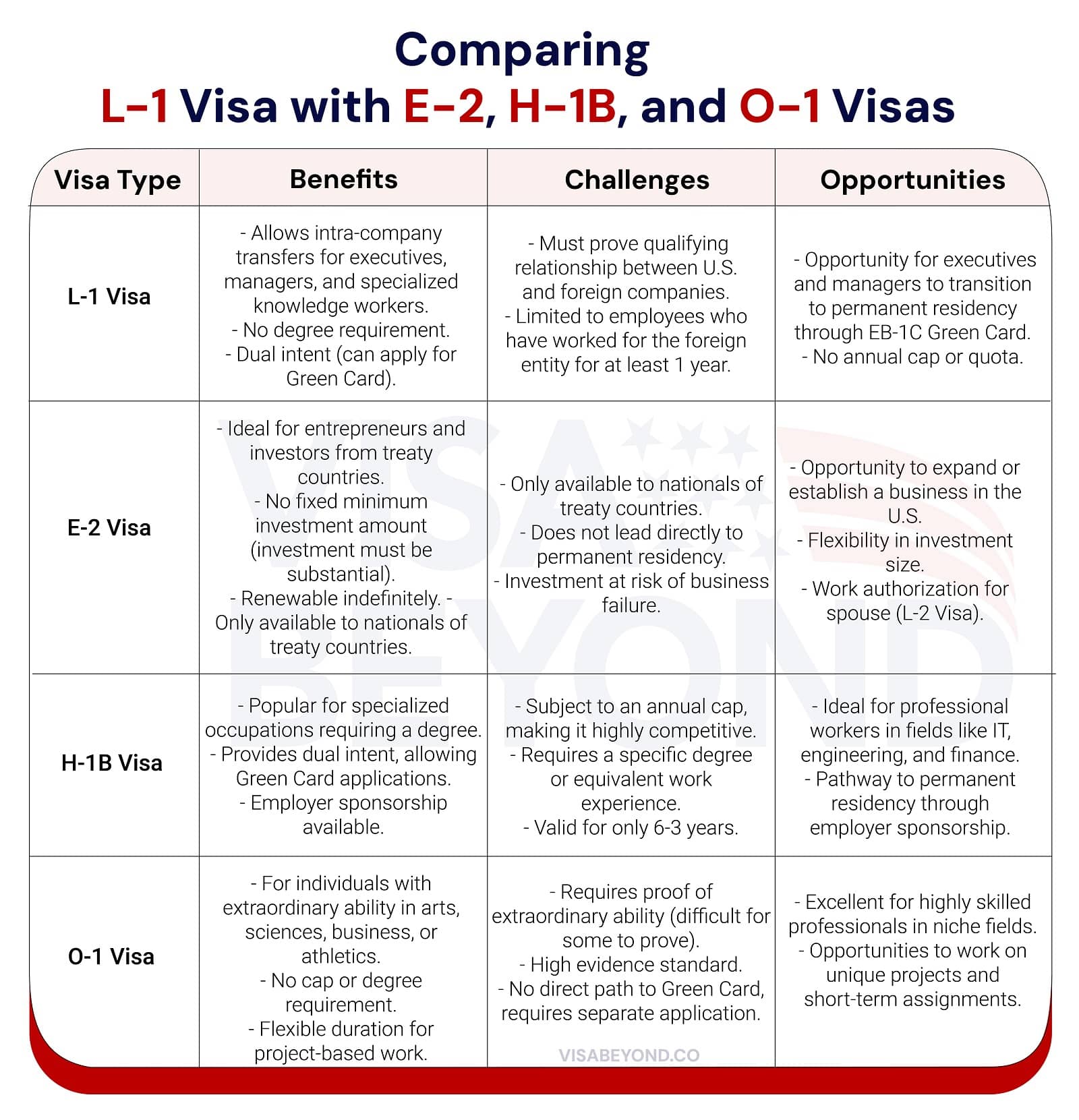
Successfully Navigating the L-1 Visa Process
Navigating the L-1 Visa process requires careful preparation, understanding of the eligibility requirements, and thorough documentation from both the employer and employee. By staying compliant with visa rules, proactively addressing challenges like RFEs or denials, and leveraging legal support when needed, businesses and individuals can maximize their chances of a smooth application and approval. Proper planning can open doors to career advancement and permanent residency options in the U.S.
Long-Term Planning and Career Opportunities for L-1 Visa Holders
For L-1 Visa holders, long-term planning is essential to make the most of the visa’s benefits. Whether aiming for a permanent residency (Green Card) through the EB-1C or other pathways, or seeking career advancement opportunities within multinational companies, the L-1 Visa offers substantial flexibility. Executives and managers on the L-1A Visa are in a strong position to transition to permanent residency, while specialized knowledge workers on the L-1B can explore career growth in the U.S. market or pursue a Green Card through other employment-based categories.
Resources and Support for L-1 Visa Applicants
L-1 Visa applicants can access a range of resources and support services to assist them throughout the process. Staying informed through USCIS guidelines, immigration forums, and company HR departments can provide helpful insights. Additionally, consulting with immigration experts ensures that the application process remains on track and fully compliant with U.S. laws.
"*" indicates required fields
